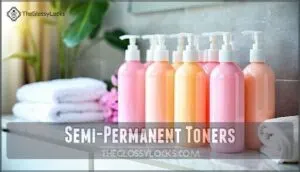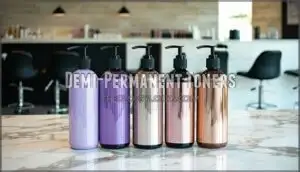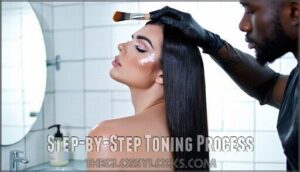This site is supported by our readers. We may earn a commission, at no cost to you, if you purchase through links.

Too much toning will wreck your hair—think damage, breakage, and that awful straw feeling.
Check how your hair’s doing between sessions. Brittle or dull? Skip the next toning appointment and load up on deep conditioning instead.
The secret lies in reading your hair’s signals and choosing the right toner type for your lifestyle and maintenance preferences.
Table Of Contents
- Key Takeaways
- What Does Hair Toner Do?
- Types of Hair Toners Explained
- How Often Can You Tone Your Hair?
- Factors Affecting Toning Frequency
- How Long Does Hair Toner Last?
- How to Safely Tone Hair at Home
- Tips to Maintain Toned Hair Color
- How to Prevent Hair Damage From Toning
- Choosing The Right Hair Toner Product
- Frequently Asked Questions (FAQs)
- How long does hair toner last?
- Is hair toner safe to use?
- How often should I use hair toner?
- Is hair toner suitable for all hair types?
- Does hair toner damage my hair?
- Can you tone wet or damp hair?
- What happens if you leave toner too long?
- Can pregnant women safely use hair toner?
- Does toner work on previously colored hair?
- Should you shampoo before applying hair toner?
- Conclusion
Key Takeaways
- You can tone your hair every 4-6 weeks safely, but damaged hair needs 6-8 weeks between sessions to recover properly and avoid breakage.
- Semi-permanent toners fade faster (2-3 weeks) while permanent toners last longer (6-8 weeks), so your toning frequency depends on which type you’re using.
- Over-toning causes serious damage like dryness, breakage, and a straw-like texture, so it’s better to wait longer than risk frying your hair with too-frequent sessions.
- Your hair’s condition determines timing more than any set schedule—healthy hair tolerates regular toning while chemically-processed strands need extra recovery time between treatments.
What Does Hair Toner Do?
Ever notice how your freshly bleached hair can look more like a banana than the cool blonde you wanted? That’s where hair toner comes in.
It’s basically your color correction tool, working to cancel out those stubborn brassy yellows and oranges that show up after lightening. The result? Hair that actually matches what you had in mind.
It’s like having a color expert who knows exactly how to dial in that perfect cool blonde, silvery gray, or whatever shade you’re going for.
Neutralizing Unwanted Hair Tones
After bleaching, brassy undertones are your biggest challenge. Those orange and yellow tints can make your hair look muddy or unfinished. Hair toner fixes this problem by depositing opposite colors on the color wheel to cancel out unwanted shades.
Here’s what it addresses:
- Orange and yellow brassy undertones from bleaching
- Muddy color results from previous dye jobs
- Natural undertones that clash with your desired shade
Toner formulas work through color neutralization, depositing opposite shades on the color wheel to cancel out brassiness and achieve perfect shade adjustment.
Enhancing Hair Color Vibrancy
Toners often boost your hair’s natural shine while boosting color vibrancy through precise toning techniques. You’ll notice enhanced color maintenance when using professional-grade products that lock in pigments.
These color enhancement formulas deliver deeper, richer tones that stay vibrant between salon visits.
Toner works like a precision tool for your hair color—it amplifies your existing shades and leaves you with that coveted glossy finish.
Correcting Brassiness After Bleaching
After bleaching sessions wreak havoc on your strands, brassiness becomes your hair’s worst enemy. The neutralization process requires careful toner selection and precise application techniques to combat those unwanted yellow-orange undertones.
Color correction isn’t just about slapping on any product—you’ll need strategic post-toning care to maintain results while managing toning hair frequency for achieving the best neutralizing unwanted hair tones.
Types of Hair Toners Explained
You’ve got four main types of toners to choose from, and each one works differently on your hair.
Knowing your options lets you match the right strength to what you’re trying to achieve—and figure out how often you can tone without frying your hair.
Semi-Permanent Toners
When you’re looking for gentle formulas with greatest color longevity, SemiPermanent Toners are your go-to choice. These hair toner options deposit pigment without harsh chemicals, making toning hair frequency safer for regular hair color maintenance.
Best practices include proper application techniques to minimize hair damage while achieving vibrant results that fade gracefully over time.
Demi-Permanent Toners
With their ammonia-free benefits, demi-permanent toners offer gentle color correction without harsh damage. These liquid-based formulas tackle brassiness and unwanted undertones while maintaining hair health.
Best brands like Wella and Redken provide salon-quality results for toning hair at home. Expect a 4-6 week fading timeline with proper application techniques for best hair color maintenance.
Permanent Toners
Permanent toners pack the strongest punch against brassiness and undertones. High Lift Permanent Toners contain boost ingredients that lift hair one level while toning. Regular Permanent Toners focus purely on color correction without lifting.
When to use these powerhouses? When you need long-lasting results that won’t fade quickly. Permanent Toner Lifespan extends 6-8 weeks, but Permanent Toner Damage risks increase with frequent use.
Toning Shampoos and Masks
Toning shampoos and masks offer gentler alternatives for maintaining hair color vibrancy between salon visits. Purple shampoos combat brassiness through color depositing shampoo ingredients, while purple masks provide deeper hydration balance and protein infusion. Here’s how they work:
- Weekly purple shampoo usage prevents yellow tones
- Monthly mask application restores moisture levels
- Color depositing formulas neutralize unwanted hues
- Protein-rich ingredients strengthen hair structure
- Gradual toning maintains consistent results without damage
How Often Can You Tone Your Hair?
You can generally tone your hair every 4-6 weeks, but this timing depends on your hair’s condition, the type of toner you’re using, and whether you’re going professional or DIY.
Over-toning can lead to serious damage like breakage and dryness, so it’s better to wait a bit longer than risk frying your hair.
General Frequency Guidelines
You’ll want to space out your toning sessions based on your hair’s needs and lifestyle factors. Most hair types can handle toning every 4-6 weeks, but this varies with hair regrowth rates and personal preference.
Seasonal changes might affect your schedule—summer sun can fade toner faster. Your hair toner choice and maintaining hair color vibrancy goals determine ideal toning intervals between salon visits.
Professional Vs. At-Home Toning
Most hair stylists recommend professional salon visits every 4-6 weeks for best salon toner longevity, while at-home toning offers convenience but requires careful technique to avoid DIY toner mistakes.
- Professional expertise: Hair stylists assess your specific needs and prevent damage
- At-home convenience: You control timing and avoid frequent salon visits
- Cost comparison: Professional services cost more but last longer
- Types of hair toners: Salons use stronger formulas than toning shampoos and masks
Risks of Over-Toning
While professional toning offers precision, overdoing it at home can wreak havoc. Over-toning causes hair breakage, split ends, and loss of luster through chemical damage. Your hair’s porosity increases dramatically, making color-treated hair vulnerable.
Different types of hair toners affect frequency—permanent formulas need longer breaks between applications for proper hair care. Signs of damage can include dryness in hair, so be cautious.
Factors Affecting Toning Frequency
Your hair’s unique characteristics and the products you choose determine how frequently you can safely tone without causing damage.
Just like with skincare routines, your individual hair needs matter more than following someone else’s regimen—what works perfectly for your friend’s thick, resilient hair could spell disaster for your delicate, processed locks.
Hair Condition and Health
Your hair’s current condition acts like a roadmap for toning frequency. Healthy hair tolerates toning every 4-6 weeks, while damaged strands need 6-8 weeks between sessions. Here’s what matters most for your hair health:
- Elasticity test – Stretch a wet strand; it should bounce back without breaking
- Cuticle smoothness – Rough texture means you need more recovery time
- Protein balance – Over-processed hair feels brittle and needs strengthening treatments
- Scalp health – Irritation or sensitivity requires longer waiting periods
- Damage prevention – Deep conditioning between sessions maintains hair treatment effectiveness
Color-treated hair with compromised cuticles absorbs toner unevenly, making damage prevention essential for consistent results. Toners can also neutralize unwanted tones, such as brassiness.
Hair Color and Porosity
Your hair’s porosity levels and current color dramatically impact how often you can safely tone. High porosity hair absorbs color faster but releases it quicker, requiring more frequent touch-ups. Blonde hair usually needs toning every 4-6 weeks, while color-treated hair may need less frequent sessions to prevent damage indicators.
| Hair Color | Toning Frequency |
|---|---|
| Natural Blonde | Every 6-8 weeks |
| Bleached Blonde | Every 4-6 weeks |
| Color-Treated Dark | Every 8-10 weeks |
| Damaged Hair | Every 10-12 weeks |
Type of Toner Used
Different toner formulations dramatically affect how often you’ll need touch-ups. Here’s what determines your toning schedule:
- Demi-permanent toners fade faster, requiring touch-ups every 4-6 weeks
- Purple toner for ash blonde maintenance needs weekly applications
- Permanent formulations with stronger toner ingredients last 8-10 weeks
- Professional toner brands offer better toner longevity versus drugstore options
- Application methods impact how well your hair color holds between sessions
How Long Does Hair Toner Last?
Your toner’s lifespan depends on the type you choose, with professional treatments lasting 6-8 weeks while at-home options fade within 2-4 weeks.
You’ll know it’s time for a refresh when those pesky brassy tones start creeping back in or your color looks dull and lifeless.
Duration by Toner Type
Understanding toner longevity helps you plan your hair color maintenance schedule. Semi-permanent duration ranges from 4-12 washes, lasting roughly 2-3 weeks. Demi-permanent toners offer better staying power at 12-25 shampoos, usually 4-6 weeks.
Permanent hair toner provides the longest lifespan, requiring touch-ups only when new growth appears.
Purple toner and other shampoo effects fade fastest, needing weekly reapplication.
Signs Your Hair Needs Retoning
Spotting when your hair color needs a refresh isn’t rocket science. Your ash blonde starts looking more like yesterday’s newspaper, and those orange-yellow undertones creep back in like uninvited guests. Color-treated hair tells its own story through visual cues.
- Uneven Color patches appear where your hair toner has faded unevenly
- Brassy Roots show through as your natural hair grows and porosity changes
- Dullness Appears when your hair color loses its vibrancy and looks flat
How to Safely Tone Hair at Home
You can achieve salon-quality toning results at home with the right techniques and products, but proper preparation is key for avoiding hair damage.
Start with a strand test to determine processing time, then follow a systematic approach that includes using toning shampoos between professional treatments.
Performing a Hair Strand Test
Your hair’s safety depends on testing first. Before choosing hair toner products, perform a strand test to check toner reaction and preview color results. This damage potential check and allergy risk assessment protects color-treated hair from unexpected disasters.
| Test Factor | What to Check |
|---|---|
| Color Match | Does the toner create your desired shade? |
| Processing Time | How long until the hair dye achieves results? |
| Damage Signs | Any breakage, dryness, or texture changes? |
| Allergic Reaction | Itching, burning, or skin irritation present? |
| Hair Condition | Can your hair handle the toning process? |
Step-by-Step Toning Process
Once you’ve completed your strand test, it’s time to tackle the full toner application. Mix your hair toner with 10 Vol developer according to package directions.
Start sectioning hair into manageable quarters, then apply from root to tip for even distribution. Work quickly but methodically—timing is crucial since DemiPermanent Toners and hair gloss act fast to neutralize unwanted tones in your hair color.
Using Toning Shampoos and Conditioners
Toning shampoos and conditioners offer gentler color maintenance between salon visits. Purple shampoos neutralize yellow tones in blonde hair, while blue-based formulas tackle orange brassiness.
Apply these products 2-3 times weekly, focusing on mid-lengths and ends. The shampoo ingredients work gradually, so patience pays off. Always follow with a moisturizing conditioner for best results.
Tips to Maintain Toned Hair Color
You’ve invested time and effort into achieving that perfect toned shade, so let’s keep it looking salon-fresh for as long as possible.
The right maintenance routine can extend your toner’s life from the typical 4-6 weeks to nearly two months, saving you both time and money on frequent touch-ups.
Minimizing Wash Frequency
Every two to three days works best for color-treated hair instead of daily washing. Your hair toner and purple shampoos last longer when you skip frequent washes.
Use dry shampoo between washes to control oil buildup while protecting your scalp health. This simple switch prevents product residue from stripping your toning shampoos and toning conditioners too quickly.
Using Sulfate-Free Products
Switch to colorsafe products for better results. Sulfate-free shampoos offer gentle cleansing without stripping your hair toner’s pigments. These products maintain hydration balance while supporting scalp health.
Purple shampoos and toning shampoos work best when sulfate-free, extending color longevity considerably. Your colortreated hair stays vibrant longer with sulfate-free benefits protecting those expensive salon visits.
Protecting Hair From UV Damage
Sun exposure can fade your freshly toned hair color faster than you’d like. Use protective hair products with UV filters before heading outdoors. Wearing hats creates a shield against harmful rays that strip color-treated hair.
Stay hydrated and avoid heat styling on sunny days to prevent double damage. Your hair toner investment deserves this extra protection.
How to Prevent Hair Damage From Toning
You’ll want to give your hair adequate recovery time between toning sessions to prevent cumulative damage from chemical processing. Think of it like giving your hair a breather—most stylists recommend waiting at least 4-6 weeks between professional toning appointments, while at-home touch-ups should be spaced even further apart.
Recommended Waiting Periods
Give your hair time to bounce back between toning sessions. Your scalp sensitivity and hair elasticity need proper toning recovery to prevent damage from hair coloring treatments. Product buildup can worsen during frequent ash blonde touch-ups, so protecting color-treated hair means spacing appointments wisely.
- Wait 4-6 weeks between professional hair toner applications
- Allow 6-8 weeks for damaged or chemically-processed hair color maintenance
- Schedule monthly consultations to assess hair condition and prevent over-processing
Deep Conditioning Treatments
Post-Toning Hydration becomes your hair’s lifeline after chemical processing. Professional Recommendations suggest deep conditioning treatments weekly, focusing on Treatment Ingredients like keratin and argan oil.
Your Application Techniques matter—distribute product from mid-length to ends, avoiding roots. These treatments restore Maintaining Elasticity while Protecting color-treated hair from further damage.
Make conditioning part of your regular hair routine for peak hair color longevity.
Recognizing Signs of Damage
Several warning signs tell you when hair toner has crossed the line from helpful to harmful. Your hair cuticle becomes your best damage detector—watch for these telltale Breakage Indicators:
- Split Ends appearing faster than usual after toning
- Dullness replacing your hair’s natural shine
- Uneven Texture feeling rough or straw-like
- Elasticity Loss causing strands to snap when stretched
Protecting color-treated hair means recognizing these red flags early, especially after sun exposure or heat styling sessions.
Choosing The Right Hair Toner Product
You’ll want to match your toner’s strength and undertone to your specific hair color and porosity level, since using the wrong formula can leave you with muddy results or patchy coverage.
It’s similar to picking house paint—you need the right formula for the job. The same goes for choosing between demi-permanent, semi-permanent, or permanent toners based on what your hair actually needs.
Matching Toner to Hair Color
Your hair’s current shade depth determines which toner undertones you’ll need. Use the color wheel as your guide—orange-yellow undertones require ash blonde or blue-based toners for corrective toning.
Blondify toners work best on lighter hair, while deeper shades need stronger formulations. Match complementary colors to neutralize unwanted tones effectively.
Consulting With a Professional
Professional colorists bring expertise you can’t Google. They’ll assess your hair cuticle condition, understand the color wheel theory, and create Custom Color Blends designed for your Long-Term Hair Goals.
Salon Consultation Benefits include:
- Corrective Toning Expertise for damaged hair
- Professional Product Recommendations for your hair routine
- Protecting color-treated hair strategies
- Hair Toner selection based on porosity testing
Best Toners for At-Home Use
When choosing Budget Options for at-home Hair Toner, consider these top picks. Wella’s Intense Silver Blonde Toner 100B and Pearl Blonde Toner 10V deliver salon results without breaking the bank. User Reviews consistently praise their Application Techniques and Ingredient Safety.
| Toner Type | Best For |
|---|---|
| Intense Pearl Blonde Toner 100V | Warm blonde tones |
| Silver Blonde Toner 10B | Cool ashy results |
| Budget drugstore options | First-time users |
Frequently Asked Questions (FAQs)
How long does hair toner last?
Most toners fade after 4-6 weeks or about 20 shampoos. Your color’s longevity depends on your hair’s porosity, the toner type used, and how you care for it afterward.
Is hair toner safe to use?
Yes, you can safely use hair toner when applied correctly. Quality toners are formulated to be gentle, but you’ll want proper application and timing to avoid damage or dryness.
How often should I use hair toner?
You should tone your hair every 4-6 weeks to maintain color without damaging it.
Wait at least four weeks between sessions—your hair needs recovery time to stay healthy and strong.
Is hair toner suitable for all hair types?
Hair toner works on most hair types, but you’ll see the biggest difference on bleached or lightened hair.
If your hair is darker, you’ll need to lighten it first before toning will make much impact.
Does hair toner damage my hair?
Hair toner isn’t inherently damaging when used properly, but overuse can cause dryness and breakage. You’ll want to space treatments 4-6 weeks apart and use deep conditioning masks afterward.
Can you tone wet or damp hair?
Damp hair’s your golden ticket, wet hair’s a no-go.
Applying toner to damp hair helps distribute the product more evenly and ensures that it penetrates the hair shaft perfectly.
Soaking wet dilutes everything, towel-dried hair gives you optimal color control.
What happens if you leave toner too long?
Leaving toner on too long can cause serious damage to your strands. You’ll risk overprocessing, which leads to dryness, breakage, and unwanted color shifts that’ll leave you regretting that extra time.
Can pregnant women safely use hair toner?
Wondering about your baby bump’s beauty routine? You’re generally safe using hair toner during pregnancy. Medical experts confirm minimal scalp absorption and consider hair treatments non-toxic for your fetus.
Does toner work on previously colored hair?
Yes, toner works on previously colored hair! You can tone over existing color to neutralize brassiness or shift undertones.
However, toner won’t lighten darker shades—it only deposits pigment to adjust your current color.
Should you shampoo before applying hair toner?
You’ll want to shampoo first to remove buildup and oils. Clean hair grabs toner better, giving you more even results.
Skip conditioner though—it’ll create a barrier that blocks toner absorption.
Conclusion
Here’s the thing about toning your hair—it’s not a race. Your hair will tell you when it’s ready for another round, and ignoring those signals is a recipe for disaster.
Your hair isn’t on a timer—it’s sending signals about when it’s ready for the next toning session, and rushing the process only leads to damage
Most hair can handle toning every 4-6 weeks, but damaged or over-processed hair needs longer breaks. Healthy hair holds toner better and looks more vibrant. Give your hair the care it deserves between sessions.
- https://www.hair.com/what-is-hair-toner.html
- https://www.instagram.com/reel/DIDPzn-uVms/
- https://www.sellerspree.com/blog/toning-frequency-how-often-can-tone-hair-without-damage-sellerspree/
- https://scandinavianbiolabs.com/blogs/journal/do-toners-damage-hair
- https://kenraprofessional.com/blog/what-is-hair-toner















